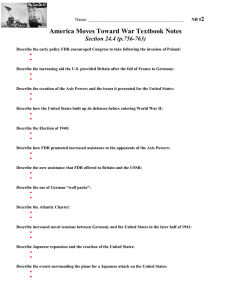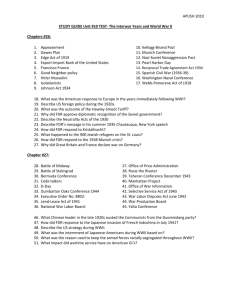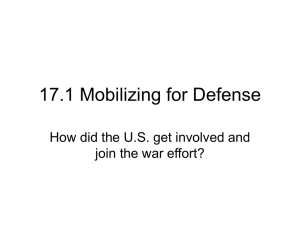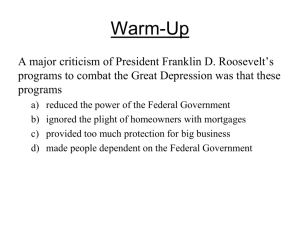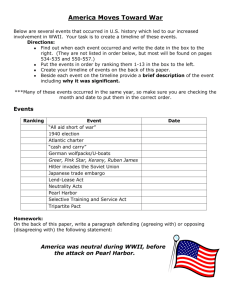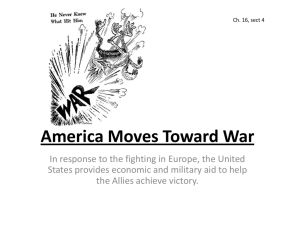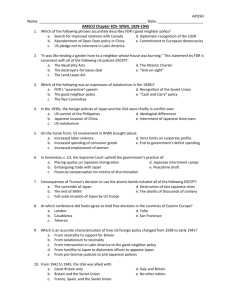America Moves Toward War
advertisement
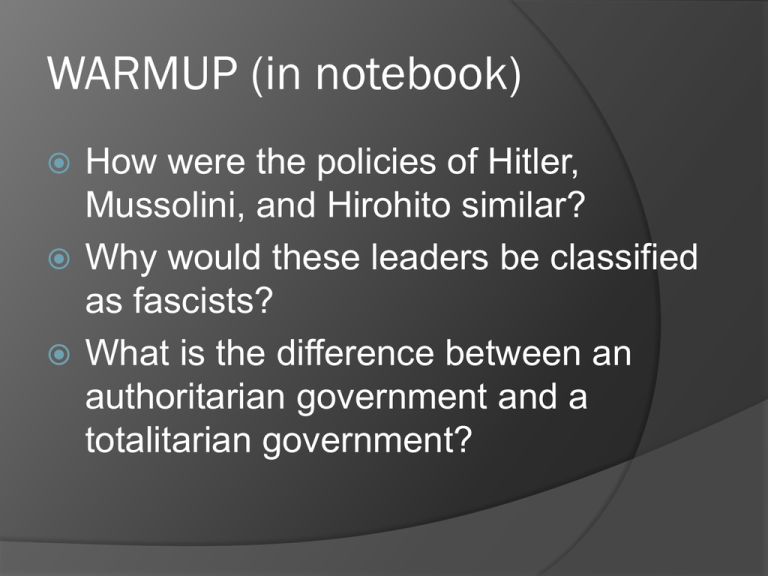
WARMUP (in notebook) How were the policies of Hitler, Mussolini, and Hirohito similar? Why would these leaders be classified as fascists? What is the difference between an authoritarian government and a totalitarian government? Unit 7: WWII Essential Question Why did the US enter WWII? Italy - Benito Mussolini: Dictator who strengthened the military & took control of Italy Germany - Adolf Hitler Gained power in 1933; violently anti-Semitic leader of the Third Reich Totalitarianism Governments that restrict personal freedoms and political opposition Japan Emperor Hirohito & military leaders take power; Japan takes over Chinese territory of Manchuria Event Response/Effect Mussolini & Italy invade Ethiopia League of Nations imposes sanctions; no real effect Germany annexes the Rhineland, Austria, & the Sudetenland Appeasement – Giving in to demands in order to avoid future conflicts Munich Pact – Germany promises not to capture any more territory Germany signs Non-Aggression Pact with the Soviet Union Germany plans to attack France; Germany & USSR will split Poland FDR stated neutrality, but at the same time he knew action would eventually have to be taken. Timeline of Events leading to US entrance into WWII September 8, 1939 FDR calls Congress into a special session to revise the Neutrality Acts. The Neutrality Acts had been passed in 1935 which outlawed sales of arms or loans to nations in war or in civil war. At this time, FDR asked to allow American arms to be sold to warring nations if they paid cash and shipped them in their own ships (cash and carry) After six weeks, Congress passed FDR’s request. “ I do not believe that we can become an arsenal for one belligerent without becoming a target for another.” -Senator Arthur Vandenberg What steps would the US take in the next few months to make it less neutral? Event Response/Effect Germany’s war technique “blitzkrieg” – lightning war rapid air & land strikes, overpower enemies Germany captures most of Europe, including France Battle of Britain Germany bombs Britain almost daily (July-Oct 1940) Leadership of P.M. Winston Churchill helps Great Britain win, Germany calls off attack Timeline of events leading to US entering WWII Spring to Summer 1940 Even with cash and carry in effect, allied forces continue to fall in Europe. September 1940 Japan, Germany, and Italy signed a mutual defense treaty, known as the Tripartite Pact, and are referred to as the Axis Powers. This pact was similar to the alliances of WWI. This meant that if the US decided to enter WWII, it would have to fight on two fronts, not just one. Timeline of events leading to US entering WWII November 1940 FDR re-elected to a third term with 55 % of the vote. Shortly afterward, the President begins to prepare the nation for war, stating that we would need to be the “great arsenal of democracy.” Didn’t we learn our lesson from WWI? What made it different this time? Timeline of events leading to US entering WWII Winter 1940 Britain runs out of money to purchase arms from the United States. FDR proposes a new program, known as lend-lease. Under this provision, the US would lend or lease arms and other supplies to any country “whose defense was vital to the United States.” Timeline of events leading to US entering WWII Winter 1940 FDR steps up his aid of military equipment to Britain. Under “Lend-Lease”, the US gave Britain ships to borrow in exchange for leases on their bases in other parts of the world. At the same time, FDR asks congress to increase defense spending, which they approve in addition to instituting a draft. Timeline of events leading to US entering WWII Spring 1941 Although isolationists fought lend-lease, Congress passes the provision with an initial appropriation of $7 billion, eventually spending $50 billion. June 22, 1941 Hitler ignores peace treaty with Soviet Union and invades with 3 million troops. Lend-lease is eventually extended to the Soviet Union as well due to their scorched earth policy of warfare. Timeline of events leading to US entering WWII Spring 1941 To stop shipment of arms, the Germans once again deploy U-Boats into the Atlantic Ocean, usually in groups of 15-20 known as Wolf Packs. In five weeks alone in 1941, the Germans successfully sank 1.2 million tons of British shipping. June 1941 FDR orders the US navy to protect lend-lease shipments as far as Iceland and to attack U-Boats in necessary for self-defense. Timeline of events leading to US entering WWII August 1941 Congress authorized the draft for another 18 months, with high isolationist opposition. FDR and Churchill meet secretly off of Newfoundland and agree to the Atlantic Charter. The document spelled out what the goals of Britain and the US would be after the end of WWII. Atlantic Charter Provisions No territorial expansion No territorial changes without consent of inhabitants People should be allowed to choose their form of government Free trade among nations Encourage international cooperation A secure peace based on freedom from want or fear Disarmament of aggressors A permanent system of general security DOES THIS SOUND FAMILIAR? THINK BACK! How was this similar to Wilson’s 14 points? - Lend-Lease Act (1940) US can send aid to any nation whose defense was vital to US national security (i.e. Allies) The US Moves Towards Intervention: - Atlantic Charter (1941) FDR meets with Churchill, strengthens alliance Timeline of events leading to US entering WWII September 4, 1941 German U-boats fire on the USS Greer, and FDR responds by commanding that US shoot German ships on sight. This move essentially started the naval war between the US and Germany Fall 1941 26 nations sign the Atlantic Charter, now known as the “Declaration by the United Nations.” These 26 nations become known as the Allies, counterpart to the Axis. Timeline of events leading to US entering WWII Fall 1941 As shipping incidents increase, the US senate repeals the ban against arming merchant ships, making us one step closer to war. What was happening on the other side of the ocean? While the US seem preoccupied with Germany, Japan was increasing to build up its war machine. By July of 1941, Japan had invaded Manchuria (1931), China (1937), Indochina (1941), and many of the outlying islands except for those occupied by the United States. By now, tensions were mounting between these two nations. Timeline of events leading to US entering WWII July 1941 As the Japanese entered Indochina, the US responded by cutting off trade with Japan, imposing an embargo. At the heart of this embargo was oil, which Japan needed for its war machine. Japanese Navy informs government that oil reserves will be exhausted within two years. Japanese begin planning invasion of Southeast Asia to take oil fields in Dutch East Indies. October 1941 Japanese general Hideki Tojo becomes prime minister of Japan, promising to attempt peace with the Americans, but to go to war if they failed. Timeline of events leading to US entering WWII Japan fears an attack on British and Dutch colonies will cause the U.S. to enter the war. Begins planning for attack on Pearl Harbor to neutralize U.S. Pacific Fleet. Goals of the attack Destroy or disable the Pacific Fleet battleships. Destroy or disable the Pacific Fleet aircraft carriers. Destroy fuel storage and repair facilities at Pearl Harbor. Hirohito approves plan for war against U.S., Holland, and Britain on Nov. 5, 1941. Attack planed for early December if diplomatic solution not reached. Timeline of events leading to US entering WWII November 5, 1941 Japan sends a peace envoy to Washington, but at the same time orders the Japanese navy to prepare for an attack on the US. Late November, 1941 US intelligence breaks Japanese code, discovering that an attack was likely on the United States by Japan, but it was unknown when or where this would occur. FDR issues a war warning to forces in Hawaii, Guam, and the Philippines while peace talks continued. The Plan of attack Japanese will attack harbor with three waves of planes from their aircraft carriers. First two waves will destroy battleships and airfields, third wave will destroy fuel storage and repair facilities. 5 midget subs will sneak into harbor and torpedo ships. U.S. Preparedness Planes at airbases parked in the open, close together to protect against sabotage. Battleships moored side by side in rows for the same reason. U.S. radar station picks up approaching Japanese planes, but report is misinterpreted. Attack begins at 7:48a.m. Sunday, Dec. 7, 1941 U.S. Fleet caught totally by surprise, most sailors asleep below deck. Timeline of events leading to US entering WWII December 6, 1941 US intelligence intercepts another Japanese message that instructed the peace envoy to reject all American peace proposals. FDR fears war is likely December 7, 1941 Japanese air forces attack Pearl Harbor. After about two hours, Japan lost 29 planes while the US lost 2 battleships (and 16 ships damaged), 188 planes (159 damaged), and about 2400 soldiers. Japan’s Push to Intervention: - US/Japan Prior to the Attack: US trade embargo; trying to halt Japanese expansion - Tripartite Pact Military alliance between Germany, Italy, & Japan - Japan attacks Pearl Harbor: Dec. 7, 1941 2,400 killed, 188 aircraft destroyed; US declares war on Japan http://www.time.com/time/video /player/0,32068,1313122074001 _2101696,00.html http://www.youtube.com/watch? v=Sv1niwxQgoY&safe=active Consequences 3rd wave not launched, Japanese fail to destroy fuel storage and repair facilities. U.S. aircraft carriers not at Pearl Harbor on Dec. 7th Japanese surprise attack causes American public to instantly change isolationist views. The next day, FDR addressed a joint session of Congress, asking for a resolution of war against Japan. U.S. declares war on Japan on Dec. 8, 1941. Germany and Italy declare war on the U.S. on Dec. 11, 1941 1942 Newsreel http://archive.org/details/NewsPara1942
